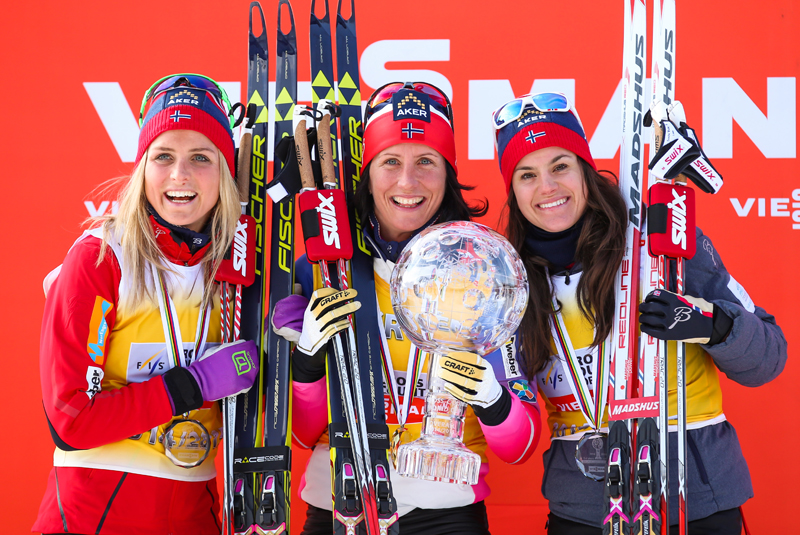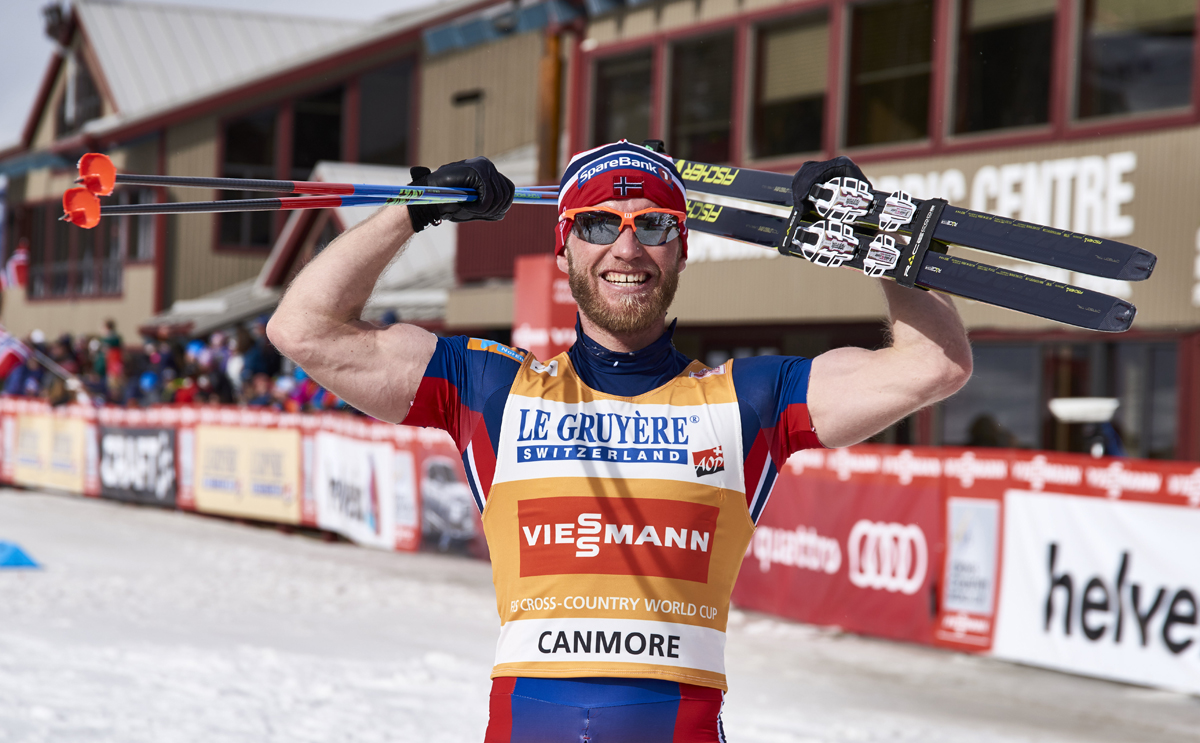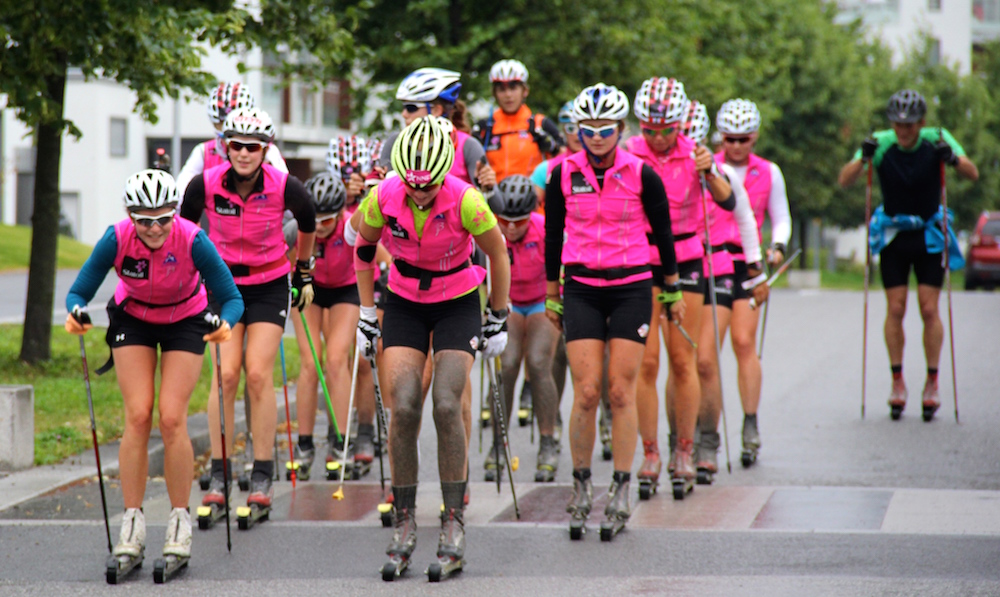
Note: FasterSkier has carried many articles of training hours before, including a 2010 discussion with Marty Hall, Eli Brown, and Pete Vordenberg, and a 2012 piece by Pete Phillips. With recent discussion of training loads by elite Norwegian athletes, it seemed time to bring the topic up again. We got in touch with Jodi Hawley, an exercise physiologist formerly based at the Canadian Sports Institute in Calgary. She now works for PacificSport Columbia Basin doing community development work.
A recent research paper revealed not only the physiology, but also the basic training regimens of six Norwegian women – who happen to be the six best cross-country skiers in the world.
Among the revelations? The year before the study was done, superstar Marit Bjørgen had trained 980 hours, while the six women as a group averaged out at 920.
That’s a lot more specificity than fans and lower-level racers typically get about elite training loads. While Norwegian World Cup champion Martin Johnsrud Sundby talks about training over 1,000 hours a year, for most of the rest of the field all one can see are averages reported in various papers.
Upwards of 900 hours per year is more than had been previously reported in such papers. For instance, a 2013 paper looked at the training loads of Norwegian and Swedish cross-country skiers who had won Olympic gold medals in the last decade. In general, the sprint specialists trained 750-850 hours per year, and the distance specialists about 50 hours more.
Another paper, published in 2014, assessed Norwegian gold medalists in cross-country skiing and biathlon. The eleven athletes had averaged 770 hours of training in their gold medal seasons.
“Most people on the World Cup – and I don’t think there’s a big difference between men and women – most people who are consistently finishing in the top 15 are probably training somewhere between 675 and 900 hours,” said Jodi Hawley, a sports physiologist who formerly worked with the Canadian National Ski Team. “The range is that wide.”
All other factors being equal, Hawley said in an interview last weekend, the athlete who trains the most will be the fastest. But all other things are not equal, including genetics, personal history, injury and illness, resources, and training partners.
Training 980 hours won’t necessarily make a mediocre skier a Marit Bjørgen – and training less than 980 hours won’t necessarily keep them from success, either.
“Some people will get faster by going slow, by training their efficiency,” Hawley explained. “Other people will get faster by training their power. So it depends a little bit on what kind of person you are. If you are the kind of person who gets faster by training your efficiency, you’re going to end up training more hours. The kind of training you need to do takes more time to get a training effect.”
Women Working Hard
![Norway's Marit Bjørgen (c) celebrates her 15th World Championships gold and record-setting 30th overall medal (between Olympics and World Championships) with a classic-sprint win at 2015 World Championships in Falun, Sweden. "It took years for her to build up to doing [980 hours]," said Hawley. (Photo: FlyingPointRoad)](http://fasterskier.com/wp-content/blogs.dir/1/files/2015/02/SMF6827.jpg)
One is that all of them came up through a development pipeline which led them to this point, and all thrived under it.
“In Norway, they tend to have a system that they employ,” Hawley explained. “It’s like hockey in Canada. Everyone does it in school… you can implement your system, and you see who copes best. Those kids get picked to move on. The ones in the end who float to the top are the ones who cope best with the system, rather than the ones who potentially could have been as fast or faster if they had been exposed to some other system.”
But the system isn’t static. As of 2010, Norway’s Petter Northug was training just over 850 hours per year and Sweden’s Marcus Hellner closer to 750. Five years later, Hellner is training closer to 900 hours, but for various reasons has seen nowhere near the level of success he experienced in 2009-2012, when he won Olympic and World Championship gold and placed second in the Tour de Ski.
Training loads evolve for senior-level athletes because they must continue to push against new limits to get an adaptation and training effect.
“You never ever as an endurance athlete get to a point – doing the same thing again next year never works as well as it did the first year,” Hawley said. “Just like in the rest of your life, you need to change the stress in order to get adaptation.”
Thus even athletes in their mid-20’s or mid-30’s. U.S. skier Noah Hoffman, for example, announced on his blog that he plans to train 1000 hours this season, a big jump at age 26.
But the second piece is that skiing is changing, and so is training. Bjørgen’s hours are a great example of that, said Hawley.
“In 2003 and 2006, think about what Marit Bjørgen supposedly did at that time,” she said. “She was lifting a lot of weights, she was doing tons and tons of intensity, and she was doing it in blocks, of several days of intensity training in a row, and then a rest.”
And she was extremely successful. But that was the beginning of a period with more and more sprinting, mass starts, and racing that worked more like pack cycling with field sprints and changes of pace. Teams began to leave behind the ‘old’ style of training, designed partly around interval-start races, and innovate. The level of competition in these new formats has surged.
As has Bjørgen, who is now the most decorated female winter Olympian of all time.
“Now, she says that she does a little bit of sprints and a little bit of VO2Max kind of training, and a lot of long slow skiing,” Hawley said of Bjørgen. “She’s not really doing a lot of the things that she did a lot of almost 15 years ago now. I think that’s a pretty good representation of how nordic ski programs have approached the requirements of racing over the last 15 years… It took years for her to build up to doing [980 hours].”
Everyone’s Different
Big numbers impress. So when Sundby says he is training 1200 hours, Bjørgen says over 900, or Hoffman aims for 1000 – those are the numbers that jump out.
But there are also extremes at the other end.

“There’s people on the World Cup who do not train as much as you would think someone on the World Cup ‘should’,” Hawley said. “But they seem to manage, and if you ask them to train more they would probably find it really difficult to cope and may get slower, and would certainly get sick more of the time. If I look at that end of the extreme, there are people who are training more like junior or U23 hours, that would be like 550 or 600 hours.”
In a country like Canada or the United States, there is not such a big pool to pull potential skiers from. Thus, Hawley said, when an athlete of particular talent comes around a lot of work goes into figuring out what makes them tick: do they respond to training power, or efficiency?
Answers to those questions – gathered and discussed by all the coaches in an athlete’s life, as well as physiologists, biomechanists, and more – will determine the training character for an athlete, and what their focus is. That will then cascade towards decisions about training hours.
Although there’s an obvious need for individualization among athletes, the U.S. Ski Team and Cross Country Canada have traditionally posted “pathway” models for how many hours a skier should be training at different ages.
For instance, the U.S. Ski Team recommends training 500 hours per year by age 17 and 700+ hours per year by age 22. As of 2010, Cross Country Canada was also recommending 500 hours by age 17, but even more later: 800 by age 23 and 850 a few years later.
The same paper that described the training of Bjørgen and her teammates also assessed six national-level Norwegian skiers, two of whom had World Cup top-15’s that season. Those women – who were also in their mid-20’s – averaged just over 700 hours per year.
Is It Enough?

There’s often soul-searching in North America as fans, coaches, and athletes themselves seek to understand what separates them from competitors on the World Cup or at World Junior Championships.
A familiar refrain comes up: are we not training enough?
Hawley firmly rejects that assumption, at least for athletes who are in their national teams’ sights.
“I actually don’t think that our junior athletes now, in the last few years, are training less than their international peers,” Hawley said. “They might be training less than the extremes, but other countries are starting to have the debates that maybe those extremes are actually not good long-term for the athletes.
“When they are 14 or 15 years old, what’s being recommended by Canada is at least as many hours as what’s recommended by Sweden, by Norway,” she continued. “It’s in line. Even at the 18- or 19-year-old range, we’re recommending more. What impact that’s having on our junior skiers, I don’t know.”
Hawley admitted that she had read a “perhaps depressing” number of papers about training for elite athletes. As a physiologist, she worked not only in endurance sports; people like her should be able to design training for athletes in many sports. Hawley worked for the Scottish rugby team before heading to Calgary and nordic sport.
Around the world, she said, people with her (former) job face the same challenges. And she learned to be able to decipher the differences between training plans coming from outside of North America, and interpret what they would mean in her own team’s context.
“We definitely have a very clear understanding of what the difference is between how different countries, where they draw the line between zone three and zone four, for instance,” she said. “We know that, so when we are talking with each other we understand what we’re saying… That’s not the issue, that it’s not being measured the same way.”
So the Norwegian women’s training loads don’t come from accounting errors.
Those hours come from planning – and from six individuals being at the extreme end of human talent and determination.
“Those six women are head and shoulders above the rest of the world,” Hawley said. “You’re looking at the extreme.”
Chelsea Little
Chelsea Little is FasterSkier's Editor-At-Large. A former racer at Ford Sayre, Dartmouth College and the Craftsbury Green Racing Project, she is a PhD candidate in aquatic ecology in the @Altermatt_lab at Eawag, the Swiss Federal Institute of Aquatic Science and Technology in Zurich, Switzerland. You can follow her on twitter @ChelskiLittle.



